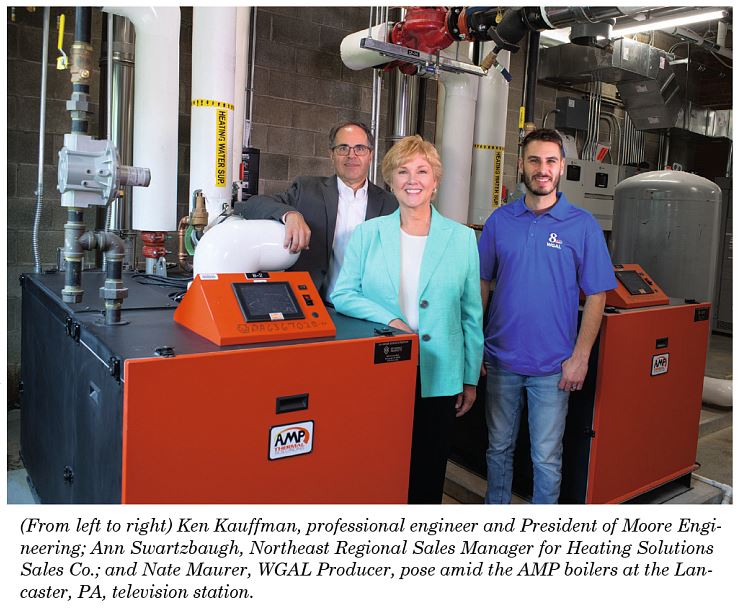Written on: December 11, 2023 by John Vastyan
It’s not often that hydronics is breaking news at a metro TV station. WGAL 8 is an NBC affiliate based in Lancaster, PA. Since its inception in 1949, the station has covered worldwide accomplishments and calamity, several wars and the partial meltdown of the nearby Three Mile Island nuclear power plant, among countless other stories.
However, hydronics? It wasn’t exactly breaking news, but WGAL’s old boilers—and a wide range of other mechanical equipment—had reached retirement age. They’d served the facility well, but it was now time to replace them.
As luck would have it, facility managers invited the expert opinion of Ken Kauffman, professional engineer and President of Lancaster-based Moore Engineering Co., prior to the onset of the COVID-19 pandemic in 2020. Just as WGAL was preparing to implement Moore Engineering’s recommendations for a comprehensive building system upgrade, the pandemic hit. The TV station, like many others around the country, shifted their operations to mainly remote locations. “The station was mostly empty for more than a year,” said Kauffman.
In the months leading up to the pandemic, Moore Engineering had prepared detailed reports of system performance, with carefully mapped projections of how its retrofit design would improve energy efficiency and mechanical system performance.

Under the magnifying glass: The entire facility
“We were hired to develop a plan to completely upgrade the HVAC systems in the facility,” explained Kauffman.
“The original building systems served the station well for decades, yet it was clear to us that modern building systems would dramatically enhance indoor air quality, operational and energy efficiency, comfort and sound—a facet of mechanical system operation that’s often overlooked.”
The engineering firm’s evaluations of mechanical, electrical and plumbing (MEP) systems were expanded to include the entire structure at precisely a time when another coincidence happened: managers recognized the need for sweeping renovations to the facility’s interior. This would entail an effort to modernize the building’s studios, offices, workspaces and a grand entry area. The building served the TV station’s needs well, but the investment in their high-level TV programming and news coverage had always taken precedence.
“Our assessment of WGAL’s building included walls, roof, insulation, lighting and accessibility,” added Kauffman.
“The sort of work we proposed would create a lot of dirt and noise—not conducive to live TV/News coverage. You simply can’t shut down the news. That’s a key reason why the building hadn’t been renovated in decades.”
Ultimately, the recommendations offered by Moore Engineering were accepted and served as the blueprint to a thorough modernization of the almost 60,000 sq ft facility. For the mechanical systems, all key parts and components were to be replaced. WGAL managers chose Gap, PA-based CMC, Inc. as the mechanical contractor to do the work. CMC’s role required an 18-month commitment; as a leading regional commercial MEP contracting firm, this was just the sort of work that fit nicely into their wheelhouse.
For the HVAC project, CMC acted as the general contractor and engaged multiple subs to perform the general construction such as structural work, walls, ceilings and painting. The MEP overhaul required replacement of the station’s chillers, boilers, pumps and air handlers. New variable air volume (VAV) systems were installed along with ductwork and controls.
Explained CMC’s Director of Operations, Eric Hodgdon, “There were four existing air handlers and two boilers in the facility that were replaced along with all of the heating and chilled water piping.”
This required much coordination and phasing to keep the facility conditioned throughout the project, according to Hodgdon, who said that CMC teams began their work in the lower level mechanical room and removed the two older cast iron boilers that were at the end of their service life. The crew then began installing new chillers, chilled water pumps and variable frequency drives (VFDs).
“When we turned on the new pumps and chillers, it allowed us to demo the old chilled water system on the second floor and also to install the new boilers and pumps,” he added.
The goal was to get the new boilers online before heating season in the Fall of 2020.
“This was made easy because of the compact design of the Thermal Solutions boilers,” Hodgdon continued, explaining that the small size allowed his team to rig the boilers through an existing window.
“The boilers’ integrated boiler control panel, high turndown and efficiency made it easy to phase in a replacement of the existing system,” he shared.
As the CMC teams completed newly finished areas, the boilers easily ramped up to meet the needs of the heating season.
“We used the existing piping and installed new valves to allow us to demo and replace piping while keeping the facility conditioned,” said Hodgdon.
CMC technicians mounted 7.5 hp pumps on vibration isolation pads to keep the transfer of mechanical noise to a minimum. Additionally, the use of VFDs and two-way control valves allowed for a much more energy efficient system, compared to the old constant volume system. Existing air handlers were replaced with Trane units and Trane VAVs.

“The new air handlers were disassembled on site and reassembled in the mechanical rooms in order to use existing openings in the building for rigging,” added Hodgdon.
According to Hodgdon, staging of temporary air handlers throughout the facility was necessary to keep engineering rooms at proper temperatures through the renovation.
“The WGAL staff was extremely accommodating and understanding throughout the whole process,” he shared.
Kauffman noted that there were initially four air handlers at WGAL. Now, there are five; an existing air handler was modified and the other three were replaced with four new ones.
“This assisted with phasing and offers greater flexibility when a unit needs to be shut down for maintenance,” he explained.
New boilers offer huge energy savings
Moore Engineering specified two 2,000 MBH condensing, natural gas-fired, Thermal Systems AMP boilers to replace WGAL’s aging boilers. The new, ultra-high efficiency, stainless steel boilers provide a 5:1 turndown, 97% efficiency, and required only half the square footage of the previous boilers.
Ann Swartzbaugh, Thermal Solutions Regional Manager, suggested that a small mechanical room on the second floor of the facility would easily accommodate the new AMP boilers.
“We’ve had plenty of previous experience with the AMP boilers and knew them to be an ideal fit for this application,” said Kauffman.
Dedicated to space heating needs at WGAL, the boilers send heated water to approximately 75 VAV boxes located throughout the TV station. According to Kauffman, there are five main air handlers that serve the HVAC needs of the building. All the VAV boxes and air handlers include hot water coils for heat and the systems provide year-round comfort at WGAL.
Ventilation was another important facet to the HVAC retrofit work, explained Kauffman.
“It was already on the list of needs to be addressed, but the COVID-19 pandemic spurred interest worldwide in the need for improved ventilation, and especially the introduction of fresh air. There’s no question that indoor air quality (IAQ) needs became a main focus through the planning process.”
Part of meeting those needs required a close look at air filtration.

“With the accommodation for continuous ventilation, we specified broad use of MERV 14 filters, which are designed to capture very small particulate and assist with maintaining clean air,” said Kauffman.
Kauffman noted that throughout the process, there were no real surprises. However, during the Summer of 2020, the need for face masks to continuously be worn at WGAL presented some discomfort for the technicians doing the work. As the station was essentially shut down, the pace of work accelerated and WGAL’s managers were nicely surprised with the reductions they saw immediately upon reoccupying the facility, such as the favorable drop in the cost of gas and electricity.
“A bit harder to discern were the vast improvements made to comfort and indoor air quality,” he added.
A significant contributor to the improved energy efficiency at WGAL happened as a result of the boiler replacement. According to Kauffman, the boiler efficiency went from 65–70% to the current mid- to high-90 percentile.
“The boiler plant played a major role in the total energy savings obtained in the project,” he noted.
Other contributing factors included new chillers, variable frequency drives, new insulation, improved controls, VAV systems, tighter ducts and LED lighting systems.
“The overall combined impact made an enormous difference in WGAL’s energy costs. Managers expressed a high level of satisfaction with the project and the new system’s performance,” Kauffman concluded. ICM
John Vastyan is CEO of Common Ground, based in Manheim, PA.